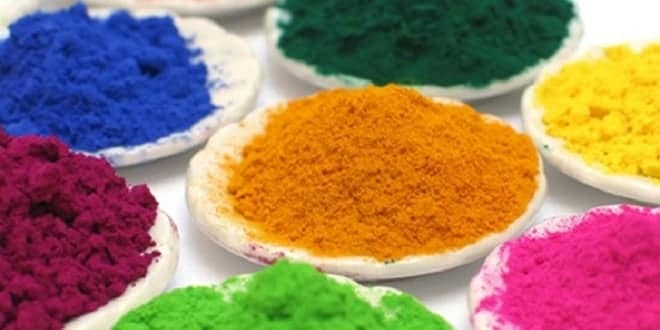Food Colors
The appearance of a food, especially its color tells a lot about its identity, quality, and flavor.
We can easily determine the ripeness and taste of many fruits based on their color.
We may be warned not to consume foods that undergone microbial spoilage by the unnatural color.
The color of food determines its acceptance by the consumers.
Brightly colored foods are eye-catching and appealing.
Natural colors
The naturally occurring pigments are a group of color substances present in animals and plants. The major colorants that naturally occur in foods include flavonoids, anthocyanins, betalains, carotenoids, chlorophyll, and myoglobin.
Flavonoids (citrus fruits), anthocyanins (grapes), betalains (red beets), carotenoids (carrots, oranges, tomatoes), and chlorophyll (green vegetables)
Flavonoids
Flavonoids (Bioflavonoids) is a general term describing a large group of polyphenolic compounds that are the most common in our diet. They are widely distributed in plants and serve many functions including flower coloration designed to attract pollinating animals. Flavonoids are classified based on their chemical structure and are grouped into anthocyanins and anthoxanthins
Anthocyanins
Anthocyanins are widely distributed in plants and are responsible for the pink, red, purple, and blue hues seen in many flowers, fruits, and vegetables. Grapes, blueberries, and cranberries owe their rich color to these organic compounds. More than 500 different anthocyanins have been isolated from plants.
The color and stability of an anthocyanin in solution dependents on pH. They are most stable and highly colored at low pH. At around pH 4–5, the anthocyanins are almost colorless, but the color loss is reversible and it will return upon acidification. This characteristic limits the application of anthocyanins as food colorants in products that have a low pH. Oxidizing agents can permanently decolorize anthocyanins. Anthocyanins are sensitive to heat.
Betalains
Betalains are water-soluble plant pigments that include the red-violet betacyanins and yellow betaxanthins. Betalains owe their name to the red beets, from which they were originally extracted. The main red pigment in red beets is betanin and the yellow pigment vulgaxantin. Betalains are stable in the pH range 3.5–7, but they are
sensitive to heat, light, and oxidation. Sources of betalains include red beets, chard, pokeberries, and Indian cactus fruit.
Carotenoids
Carotenoids are widely distributed in plants, but can also be deposited in tissues of animals.
They have yellow, orange, and red colors, found in bananas, carrots, tomatoes, pink grapefruit, and watermelon, which all contain carotenoids.
Carotenoids are not soluble in water, but are soluble in lipids.
There are over 600 carotenoids and they are split into two classes: carotenes and xanthophylls.
A β-carotene is a precursor of vitamin A. That is, it can be converted into vitamin A in the intestinal wall and in the liver.
Sources of α-carotene and β-carotene include carrots, sweet potatoes, pumpkin, citrus fruits, apricots, broccoli, and most dark green leafy vegetables.
The more intense the green, yellow, or orange color the more β- carotene the vegetable or fruit contains.
The β-carotene is not destroyed by cooking, which makes it easier to absorb.
Lycopene, a red pigment in tomatoes, is another carotene. Sources of lycopene include tomatoes, carrots, green peppers, and apricots.
Chlorophylls
Chlorophylls are widely distributed natural green pigments that occur in almost all plants. Chlorophylls are present in many unripe fruits and gradually disappear as the yellow and red carotenoids take over during ripening.
Chlorophylls occur in plants in two forms: A (blue-green) and B (yellow-green).
Presence of the long hydrocarbon chain in chlorophyll structure makes it soluble in lipids. Under alkaline conditions, the hydrocarbon chain can be cleaved, yielding chlorophyllide. Chlorophyllide is hydrophilic and it is soluble in water.
…

